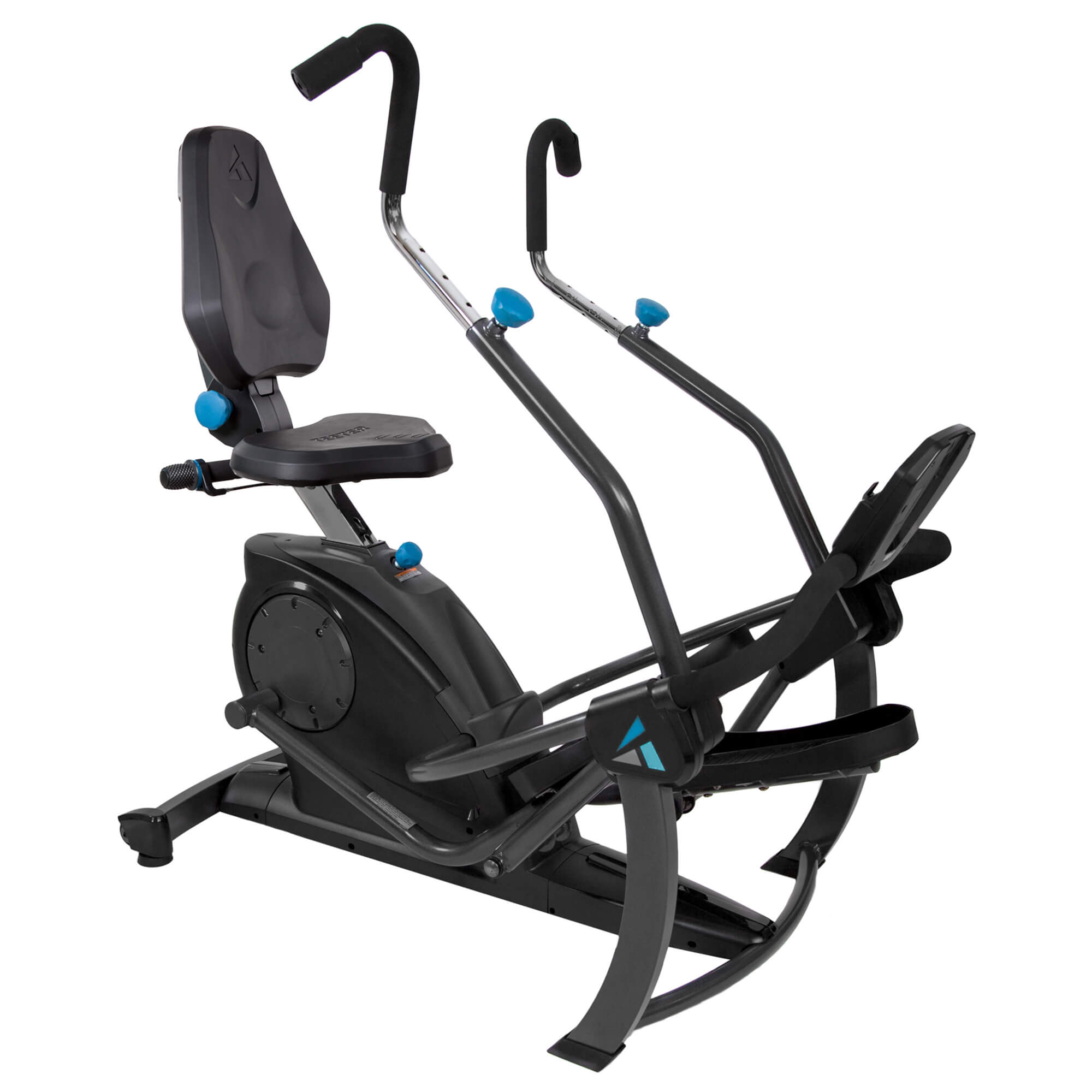Recumbent cross trainers offer a low impact way to get your joints moving and your heart working, which is great, but unfortunately, most of the top models are really expensive.
Luckily, the good folks at Teeter saw the need for an affordable option and the FreeStep LT1 was born.
With a price well under $1k, the LT1 is easily one of the most affordable recumbent trainers on the market, but unlike many really affordable machines, it actually works.
With a 15.4 lb flywheel and 13 levels of magnetic resistance, the LT1 offers quiet operation and with an adjustable incline backrest, folks with achy backs should be able to find a comfortable sitting position too.
It also comes with adjustable handles, large pedals, and free access to Teeter’s fitness app.
The biggest downside is likely the warranty – it’s really short.
But if you’re looking for a comfortable fitness machine that won’t break your budget, I think Teeter’s LT1 could make a lot of sense.
But before you decide, you should probably keep reading.
In this review, I’ll go over everything the FreeStep LT1 does and doesn’t have going for it; I’ll also try to compare it to a few other similarly priced comps to see how it stacks up.
After reading, you’ll know once and for all whether or not the LT1 is worth investing in.
Let’s begin.
The Teeter FreeStep LT1 Recumbent Cross Trainer
Recumbent cross trainers are great because they offer such a low impact form of exercise – many people find them even more comfortable to use than recumbent bikes.
They’re very similar to recumbent bikes, but instead of pedaling your feet in a circle (like you do with all exercise bikes), you push the pedals in a more linear pattern.
Like a stepper.
This straight path stepping motion, when combined with the recumbent sitting position, makes for a very low impact form of exercise and even folks with severe arthritis can usually exercise on these devices fairly comfortably.
Recumbent cross trainers also come with moving handles, so you can get your arms moving too.
This is why you see recumbent cross trainers in so many rehab and assisted living facilities.
NuStep brought us the first recumbent cross trainers and they’re still the gold standard for these machines today, but as I mentioned above, they aren’t cheap.
An entry level NuStep is going to cost ya north of $4k and that’s before you pay for delivery…
I’ve worked with NuSteps a lot through my work as a therapist and I think they’re amazing, but a lot of us just don’t have the budget to invest in one.
Luckily, Teeter offers a couple of significantly more affordable options to consider.
The LT1 we’re here to discuss now is their entry-level model, but they also have the LT3, which comes with a few subtle upgrades (mostly in the comfort department).
Pros
- Low impact, full body workout
- 15.4 lb flywheel
- 13 magnetic resistance levels
- Adjustable backrest
- Adjustable handles
- 300 lb weight limit
- Access to free fitness app
- Reasonably priced
Cons
- Only 1 year on the warranty
- Very basic monitor
Resistance
Even though recumbent cross trainers use a different stepping movement, they operate a lot like traditional home recumbent bikes.
Or at least the FreeSteps do.
And by that, I mean they create their resistance by using a weighted flywheel and a magnetic system.
And since they use the same type of resistance systems, it would make sense to think that they would also benefit from having heavier flywheels.
(Heavier flywheels build more momentum as they spin and this momentum helps keep the pedals moving a little between pedal strokes, resulting in a smoother feel).
Well, the LT1 comes with a 15.4 lb (7 kg) flywheel, which isn’t bad for the price range.
There aren’t many recumbent cross trainers in this price range to compare the LT1 to – actually, most of the affordable “cross trainers” are just recumbent bikes with attached handles.
Sunny Health & Fitness has a couple of these that cost $300 – $400 and they use flywheels in the 11 lb range.
If we compare the LT1 to some of the top recumbent bikes in this price range, its 15 lb flywheel still holds up pretty well too though.
Nautilus’ R618 uses a 13 lb flywheel, as does Schwinn’s 270.
So, even though a 15 lb flywheel isn’t massive by any means, I think it’s pretty good for this price range.
Teeter pairs that flywheel with 13 levels of magnetic resistance, which is controlled via a rotating dial located on a handle near the seat.
Most folks agree the range of available resistance is adequate for decent workouts, especially for folks dealing with or rehabbing achy joints.
Some folks don’t like the location of the resistance dial, but overall, most agree the LT1 offers a smooth pedaling motion.
Overall though, I think the LT1 scores pretty highly with a 15 lb flywheel and 13 resistance levels.
Frame
The LT1 comes with a footprint of 55″ x 38″ (L x W), which is actually a lit more compact than most home recumbent bikes, so it doesn’t take up a ton of floorspace.
More importantly though, it’s a good idea to think about how “heavy-duty” or stable you can expect it to feel during workouts.
And to do this, I think it makes sense to look at the assembled weight and weight capacity specs.
And seeing higher numbers in both areas is usually a good sign when it comes to durability and how stable it’ll feel during use.
When looking at these specs, I like to see an assembled weight of at least 100 lb and a weight limit of at least 300 lb.
That said, the LT1 comes with an assembled weight of 107 lb and a weight capacity of 300 lb.
Again, I can’t really find any true recumbent cross trainers in this price range to compare the LT1 to, but the Sunny Cross Trainer thing I mentioned earlier weighs about 70 lb and has a weight limit of 265 lb.
So, back to recumbent bikes.
The Schwinn 270 weighs in at around 87 lb and the Nautilus R618 weighs around 107 lb – based on these comps, I’d say the LT1 is pretty heavy-duty for a trainer under $1k.
And with a 300 lb weight limit, folks of most sizes will be able to use it safely.
Oh, speaking of sizes, according to Teeter, most people between 4’11” and 6’6″ should be able to fit comfortably on this machine, but keep in mind brands tend to exaggerate a little with these estimates.
Overall, I think the LT1 is about as heavy-duty as we can expect a recumbent cross trainer to be in this price range and I like that it doesn’t take up too much floor space.
Warranty
Teeter backs their FreeStep LT1 Recumbent Cross Trainer with the following home warranty:
- 1 year full coverage
Yeah, the LT1 only comes with a 1 year warranty and that includes the frame, all parts, padding, and labor.
Actually, a year on parts and labor isn’t that bad for this price range, but it would be nice to see a longer frame guarantee spelled out.
For the sake of comparison, the recumbent bikes I’ve mentioned above come with 10 – 15 year frame warranties and a couple years on parts.
Overall, I think Teeter could do a little better on their warranty, but I wouldn’t say this is necessarily a deal breaker.
Features
The Teeter LT1 comes with the following features:
Small digital monitor- the monitor on the LT1 is very small and very basic. It really only tracks your time, distance, speed, and calorie expenditure during workouts – no workout profiles, no heart rate monitoring, no USB charging, etc. It’s also not backlit, so make sure you use it in well-lit areas.
Adjustable handles- you can adjust the handles to the correct length for optimal comfort, but you can also rotate them to use different grips, allowing you to target different upper body muscle groups.
Adjustable backrest- the seat is height adjustable of course, but you can also adjust the angle of the backrest (3 options) to meet your needs. A nice feature for people dealing with bad backs.
Media tray- there’s a place to put your tablet or phone in case you want to watch while you exercise.
App- Teeter also has a free fitness app (Teeter Move) that gives you access to instructor-led workouts… did I mention that it’s free?
Water bottle holder- and finally, there’s even a place to put your water bottle during workouts.
Cost
At the time of writing this, the LT1 is going for $749, although they have the regular crossed-out price as $849.
I’m not sure how long this price will last, but I’m guessing by the time you read this the LT1 will still cost somewhere around $800.
As I’ve mentioned a few times already, there aren’t really any other true recumbent cross trainers in this price range to compare the LT1 to.
Or at least any that I’m aware of (if you know of any, please leave a comment below).
There are a few recumbent bikes with handles attached to them that go for $300 – $400, but again, these don’t use a stepping pedal movement so they aren’t real recumbent cross trainers.
There are several legit trainers in the $3k – $4k range, but I don’t think it’s fair to compare the LT1 to these either.
The only other comp I haven’t mentioned yet is Teeter’s own LT3.
The LT3 usually goes for $100 more than the LT1 and it comes with a few comfort related upgrades, including a softer seat, upgraded pedals, and thicker handles.
That’s all fine, but more importantly in my opinion – the LT3 comes with an extra year on the warranty.
So, the FreeStep trainers are kind of in a league of their own because there aren’t really any other affordable cross trainers to compare them to.
Based on what the LT1 has to offer though, I think it’s fairly priced.
Final Thoughts
Ok, that about doe is for the LT1.
All things considered, I think this is a nice piece of fitness equipment for folks looking for a safe, comfortable way to get some exercise.
In terms of performance, I like that it comes with a pretty heavy flywheel and users generally agree it offers a smooth pedaling motion during workouts.
I also like that it comes with an adjustable backrest because a lot of people who are dealing with arthritic knees and hips also have bad backs.
It would be nice if Teeter offered a longer warranty, but considering how much else the LT1 has going for it and I don’t think that’s a dealbreaker.
That said, I would certainly consider upgrading to the LT3 for the extended warranty.
Overall, I think the LT1 is a great choice for folks looking for an affordable recumbent trainer. Recommended.






